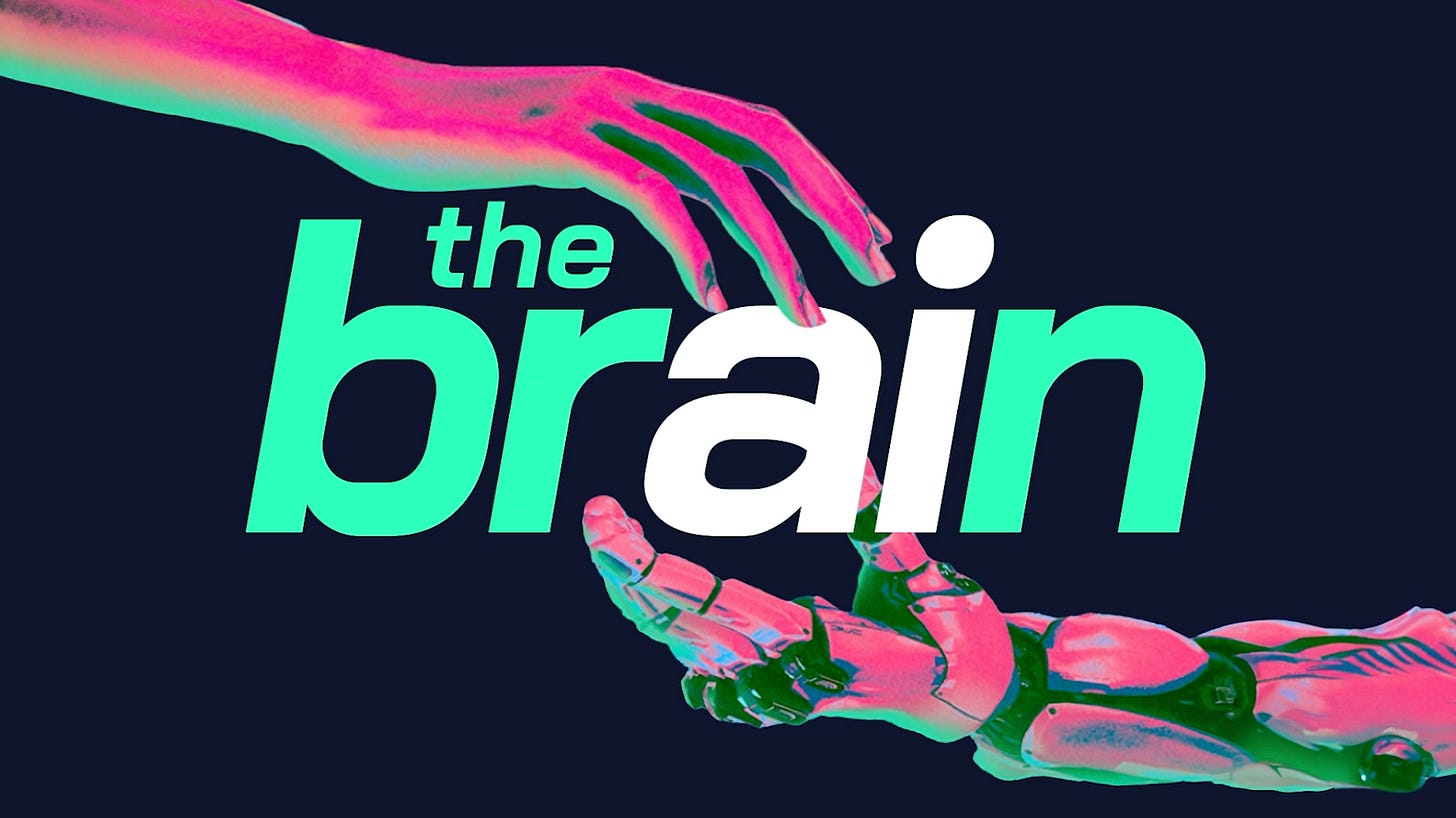H.I. v. A.I. In The Arts: One Emotes, The Other Mimics
Human Intelligence Wins Every Time Over Emotion-Less AI Tech
Welcome to your weekly “brAIn” dump. The “mAIn event” features my H.I v. A.I. grudge match in the Arts (human intelligence v. artificial) — sounds like a pithy subject, but it’s anything but. Read on, young Skywalker. Then, the “Video of the Week” — Paul Trillo’s latest AI film generated using a 100% “clean” ethically sourced model from Moonvalley. Next, it’s my related most popular article “Does AI Dumb Down Creativity?” Finally, the “AI Litigation Tracker” — updates on key GenAI cases by Partner Avery Williams of McKool Smith (access the “Tracker” via this link).
Listen to a podcast discussion of today’s HI v. AI feature story on Apple Podcasts (via the button below). You can also find my “the brAIn” pod on all podcast platforms.
But First …
(1) “Fair Use” Watch! (& Bombshell New Class Action Ruling)
Two California federal district court judges recently handed down the first GenAI “fair use” decisions — in Bartz v. Anthropic and Kadrey v. Meta (revisit my analysis of them here). Now, Anthropic (defendant in the first) filed a motion for “interlocutory appeal” on the part of the “fair use” decision it lost — based on training its LLM on content from pirate sites. Anthropic wants the Ninth Circuit Court of Appeals to reconsider that loss now and place its case on hold in the lower court. To be clear, judges rarely grant requests for interlocutory appeal. But we’ve already seen one federal judge agree to do so in an AI “fair use” decision — in Thomson Reuters v. Ross Intelligence — a non-generative AI case now before the Third Circuit Court of Appeals.
But wait, there’s more in Bartz! Late last week, federal Judge William Alsup granted the plaintiffs’ motion to certify a class action against Anthropic in connection with its use of pirated books. Not a good development for the Amazon-backed AI company that can only be fully appreciated by reading Partner Avery Williams of McKool Smith’s analysis of what it potentially means — i.e., gargantuan, existential company damages (check out Case #1 in this week’s “AI Litigation Tracker” here to read it).
(2) I Rarely (Okay, Ever) Agree With Senator Josh Hawley, But …
Hawley opened up his Senate Judiciary Subcommittee hearing about AI developers’ use of copyrighted works without consent and compensation by saying this:
“Today’s hearing is about the largest intellectual property theft in American history. For all of the talk about artificial intelligence and innovation and the future that comes out of Silicon Valley, here is the truth that nobody wants to admit: AI companies are training their models on stolen material … Are we going to protect [America’s creative community] or are we going to allow a few mega-corporations to vacuum it all up, digest it, and make billions of dollars in profits — maybe trillions — and pay nobody for it? That’s not America.”
Hard to argue with that.
I. The mAIn Event - HI v. AI In The Arts (The Emotion Of The Moment Wins Every Time)
Let me be clear. I’m not against Artificial Intelligence. How could I be? I’ve led several tech-forward media companies and benefitted from AI for years with streaming recommendations and the like. And even if I were “anti-AI,” AI is here to stay, so it would be a fool’s errand to try to wish it away. I preach “AI stoicism” — accept the reality of AI as it increasingly infiltrates society — and choose our reactions to it.
And here’s my reaction to AI in the Arts.
Yes, used as a tool in the creative process, generative AI boasts compelling benefits, including workflow efficiencies. Even so, I remain absolutely steadfast that GenAI must be based on “clean” ethically sourced models (I write about this all the time). And I’m confident that Creators ultimately will be paid (last week I laid out my proposed 3-tier licensing solution that is workable today).
But AI in the form of “The Creator” in the Arts — i.e., as the leading figure in the creative process — is something I’m entirely against both creatively and “humanistically.” This gets to the heart of the great H.I. v. A.I. debate.
What Is H.I.?
H.I., simply put, is “Human Intelligence.” Sounds so simple, but I never heard it laid out this way until I recently spoke with music business manager Gilbert Davison, who hails from my home town Minneapolis and worked closely with Prince back in the day. Gilbert works with great young talent like musician Mychael Gabriel — and the two are now focused on their H.I. headline artistic project “Genesis.” My discussion was “coincidental” (there are no coincidences!) because it immediately followed my reading of a thought-provoking “must read” article titled “What Cannot Be Said” — an article that had just been shared with me and focused on similar sentiments.
In Gilbert’s view (with which I 100% agree) generative AI can certainly effectively “mimic” the works of human creators. It can lead to impressive sounding and looking music and Art that certainly is “consumable” (and may be even satisfying). But that’s where “AI the Creator” stops — and can go no further. Meanwhile, AI’s human counter-part, HI, recognizes that music is not just an art form. “Music is an expression of the human soul,” as Gilbert so beautifully puts it.
Emotion (& The Divine Human Connection To It) Flow Only From H.I.
Human art (and the effort that goes into it) is an expression of the Artist’s emotion — and this part is critical, it’s an expression of emotion at the specific time the human Creator creates their Art. This goes for all forms of human expression — not just music.
Here’s a rather banal example. Certainly, AI can “create” my newsletters faster — and perhaps even better. But AI wouldn’t choose the same words I use today — right now as I write this (and, to be clear, I write every word of every newsletter). Nor would I choose the same words if I were to write this newsletter tomorrow, let alone 5 minutes from now. My musings — and each word I choose within them — are reflections of my human soul at that precise moment in time. And these expressions of the human soul can’t be “bottled” through AI’s scraping.
(Fun Fact: That is precisely why I asked my artistic son, Luca, to create the graphic I use for this newsletter — with the human hand over the artificial).
And if that’s the case with my writing, then just think about how the human soul — and the fleeting moment in time captured in it — are reflected in the music created by the Artist. Music is unlike any other art form. Gilbert laid it out to me this way: “Music is the highest form of communication that people have. It transcends language. It transcends international borders. You don’t even need to understand the lyrics if the music connects to your soul.”
Meanwhile A.I. “Mimics”
No slam on generative AI. Simply the truth. AI reflects no such emotion. Nor could it. The special sauce of great music and Art is its expression of the human Creator’s emotion at that specific moment. AI “creation,” on the other hand, is based on a historical record.
Eric Shamlin, CEO of leading AI studio Secret Level — the ones who brought us the breakout Coke polar bear commercial last holiday season (here’s my earlier post about that) — absolutely agrees. “AI has no sense of taste. No sense of memory. No sense of the Zeitgeist. It’s all backward-facing data-sets that tell you history,” he tells me. “There is a subjective human call for where to go [with Art],” he says. By implication, forward-looking artistic progress is only possible coming from humans.
Only H.I. Leads To Authentic Emotion That Truly “Connects”
And it’s that reflection of the Artist’s emotion/soul at that specific moment in our collective human experience that truly “connects.” Why else would all great human campaigns throughout history harness music to generate change — whether it be good, bad or ugly change. It’s the authentic emotion that fuels it.
And there’s nothing remotely authentic in a machine’s attempts to emulate it.
As we ended our conversation, Gilbert asked me if I had ever listened to the song “Maggot Brain” by the band Funkadelic. I had not. He then told me the song’s story — how the lead guitarist had just lost his mother earlier in the day — just a few hours before he went into the studio to lay down his licks. The result? Something that can’t be described by my words, precisely because it evokes the kind of undefinable human emotion that is at the heart of that article I mention above — i.e., “What Cannot Be Said.” Just listen to the song — the “bleeding” guitar — on Spotify via the button below (be patient — give it a few moments after the brief spoken introduction).
THAT is what human emotion sounds like. That is H.I. — something that A.I. can never create. Mimic, perhaps. But never emote.
What do you think? Send me your feedback to peter@creativemedia.biz.
II. Video of the Week: Paul Trillo’s Latest — Fully Clean, Fully Ethical
Innovative filmmaker Paul Trillo is back with a new AI-generated video. I feature it not just because it’s cool, but rather because it’s also 100% “clean” and ethically sourced, using Moonvalley’s fully licensed generative AI model. Watch Paul’s video via the button below.
III. “Does AI Dumb Down Creativity?”
Read my earlier article that is a companion to my feature today — “DOES AI DUMB DOWN CREATIVITY?” - which remains my most-read all-time newsletter.
IV. AI Litigation Tracker: Updates on Key Generative AI/Media Cases (by McKool Smith)
Partner Avery Williams and the team at McKool Smith (named “Plaintiff IP Firm of the Year” by The National Law Journal) lay out the facts of — and latest critical developments in — the key GenAI-focused IP litigations below. All those detailed updates can be accessed via this link to the “AI Litigation Tracker”. McKool is a leader in both copyright and patent-related AI litigation — and all IP and general media, entertainment, AI and tech matters.
(1) Bartz v. Anthropic
(2) Kadrey v. Meta
(3) The New York Times v. Microsoft & OpenAI
(4) Disney & NBCUniversal v. Midjourney
(5) Denial v. OpenAI & Microsoft
(6) Thomson Reuters v. Ross Intelligence
(7) SDNY Multi-District Litigation
(8) Reddit v. Anthropic
(9) Dow Jones, et al. v. Perplexity AI
(10) UMG Recordings v. Suno
(11) UMG Recordings v. Uncharted Labs (d/b/a Udio)
(12) Universal Music Group, et al. v. Anthropic
(13) Getty Images v. Stability AI and Midjourney
(14) Sarah Anderson v. Stability AI
NOTE: Go to the “AI Litigation Tracker” tab at the top of “the brAIn” website for the full discussions and analyses of these and other key generative AI/media litigations. And reach out to me, Peter Csathy (peter@creativemedia.biz), if you would like to be connected to McKool Smith) to discuss these and other legal and litigation issues. I’ll make the introduction.
About My Firm Creative Media
My firm and I represent media companies and rights-holders for generative AI content strategy and licensing, with deep relationships and market insights and intelligence second to none. We know the key players inside AI tech and pride ourselves in reaching THE key decision-makers and influencers in record time to execute. Not just talk. We specialize in breakthrough business development and M&A and cost-effective legal services in the worlds of media, entertainment, AI and tech.
Reach out to me at peter@creativemedia.biz to explore how I can help you.
Send your feedback to me and my newsletter via peter@creativemedia.biz.








